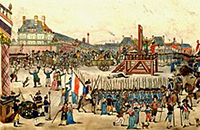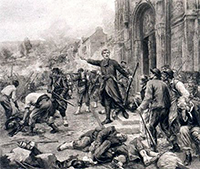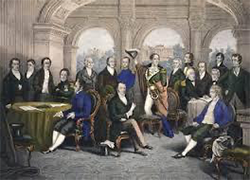The French Directory
Part 1: In the Shadow of Internal Violence The Directory was the executive arm of a new French government that followed in the wake of the Reign of Terror. For nearly its entire four-year existence, the Directory presided over upheaval, internal or external (or both). 
The Thermidorian Reaction had ended the Reign of Terror in July 1794, not only stopping the accelerating trend of executions put in motion by Maximilien Robespierre and the Committee of Public Safety and the Revolutionary Tribunal, but also freeing hundreds of political prisoners who would otherwise have been sent to the guillotine. The National Convention, the country's ruling legislature, set about drafting yet another Constitution. 
France at this point in history was in the midst of the War of the First Coalition, a struggle against multiple enemies on multiple fronts. That kind of conflict would have been expensive in any case, but it was creating a particularly high cost across the French countryside because of an already depleted tax base due to a series of bad harvests and a half decade of political upheaval. The treasury inherited by the Directory was nearly empty. On May 20, 1795, a number of Jacobins attempted a coup, following the same blueprint that had been successful in June 1793, when the Montagnards joined forces with the sans-culottes and stormed into the Convention meeting hall at the Tuileries Palace. Two years later, the political landscape was different enough that this uprising fizzled and was dispersed by the army. 
Through all of this, the Convention got on with the business of reinventing the government, again. On Aug. 22, 1795, the Convention ratified the new Constitution. The new legislature was to have two houses, an upper one called the Council of Ancients (having 250 members) and a lower one called the Council of Five Hundred. In an extreme form of power-sharing, the two councils were forced to work together because the lower house could propose legislation but not pass it and the upper house could only approve or deny legislation. In order to guarantee some continuity, the Convention decreed that at least 500 of the total 750 members must have served in the National Convention. Deputies to the Council of Five Hundred had to be 30 or older; deputies to the Council of Ancient had to be 40 or older. Making up the executive branch of the new government was the five-member Directory, the members of which came a from a list provided by the Council of Ancients. Elections for all members of both houses and the Directory would take place every year. Meanwhile, on the battlefield, France was having more success as 1795 dragged on. French troops under Gen. Jean-Charles Pichegru invaded the Dutch Republic, seized a large amount of land, and convinced the Dutch to sue for peace. By this time, Prussia was tired of the fighting and also signed a peace agreement with France. A July treaty with Spain reduced the number of French enemies to two, Austria and Great Britain. Next page > More Rebellions > Page 1, 2, 3 |
|
Social Studies for Kids
copyright 2002–2026
David White




